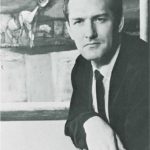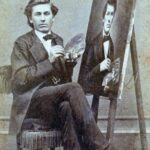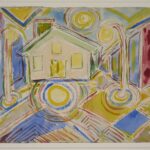Art Wraps
Downtown Arts Wraps take plain traffic engineering boxes and turns them into stunning canvasses portraying the artwork of some of the important Knoxville or East Tennessee artists from the past. Art Wraps engage the public (residents and visitors) to discover the city’s rich artistic heritage and explore the gems that are contained in our local museums and historic collections.
Each colorful wrap is enhanced with an interpretive panel featuring a photograph of the artist and a short biography describing the artist’s local connections.
BROCHURE GUIDE PDF: KHP_art wrap_brochure
Check out our Interactive Map and explore! (Click on the thumbnails for a full-size image of the work.)
 Robert Birdwell (1892-1972)
Robert Birdwell (1892-1972)
A Knoxville native, Robert Birdwell grew up in the Lonsdale area. He studied at the University of Tennessee on the GI Bill and later attended the University of Iowa’s respected School of Art. While working as a staff artist and muralist for the Tennessee Valley Authority for 30 years, he maintained a personal studio downtown. In retirement he taught art at Maryville College. Birdwell often drew inspiration from urban settings with downtown Knoxville his favorite painting location. With the Knoxville Seven, he experimented with degrees of abstraction but also focused on watercolor paintings of downtown Knoxville in a realist style.


 Lloyd Branson (1853-1925)
Lloyd Branson (1853-1925)
Lloyd Branson is regarded as Knoxville’s finest professional artist. His family moved to Knoxville from Union County in 1868 and as a youngster he exhibited extraordinary talent. After studying at the University of Tennessee, he moved to New York to study at the National Academy of Design. Back in Knoxville, Branson shared a studio with photographer Frank McCrary on Gay Street and began to establish a reputation as a regional artist, taking a gold medal for one of his most enduring paintings of the region’s marble industry, Hauling Marble at the 1910 Appalachian Exposition at Chilhowee Park.
Branson was a founder of the Nicholson Art League, and taught some of Knoxville’s most influential artists, including Catherine Wiley, and mentored Beauford Delaney.

 Ruth Cobb Brice (1899-1971)
Ruth Cobb Brice (1899-1971)
Born in Knoxville, Ruth Cobb Brice moved to Rogersville at an early age where she became a schoolteacher while during the summers, she studied at the Tennessee Agricultural & Industrial State University in Nashville. In 1928, she moved to Knoxville to teach art first at Heiskell Elementary School, then a public school for black children. In the 1940s, she began writing poetry under the pseudonym Rachel Jane McKinney and her booklet, The Wrong Slant, gives her a claim to be Knoxville’s first black female author. After 47 years of teaching, she devoted her life more fully to art and in 1968 became the first Black artist to join the invitation-only Knoxville Watercolor Society.

 Russell Briscoe (1899-1979)
Russell Briscoe (1899-1979)
Raised in Knoxville’s Fort Sanders neighborhood, Russell Briscoe enjoyed an idyllic childhood in a prosperous family before becoming an insurance executive. His early creative impulses included whimsical cartooning and making wooden toys and miniatures. When he was 58 years old his wife gifted him paint brushes and oils, with which he began to paint. For the last 20 years of his life, he was prolific, producing an estimated 75 meticulously detailed scenes of Knoxville, inspired by both nostalgic memories and local history stories. Though used his paintings to illustrate his talks about old Knoxville, the only exhibition of his work during his lifetime was in 1972, when UT’s McClung Museum exhibited his work.
 Ted Burnett (1909-1982)
Ted Burnett (1909-1982)
Born in Knoxville, Ted Burnett began his career as a teenager producing promotional displays at the then brand-new Tennessee Theatre in 1928. He studied art with Hugh Poe, a nationally known pastel artist, and Knoxville’s Robert Lindsay Mason before attending the Chicago Academy of Fine Arts and the Chicago Art Institute. Later he studied at the Eliot O’Hara Watercolor School in Maine. His first one-man show was held at UT’s Audigier Art Gallery in 1948. He opened the Ted Burnett School of Art in the late 1950s, before transitioning to paint stylized birds in the early 1970s. His Bicentennial print, “Bald Eagle,” was displayed at the White House in 1976. His works were featured posthumously at the East Tennessee History Center’s show, “Bagels and Barbecue: The Jewish Experience in Tennessee” in 2010-2011.


 Richard Clarke (1923-1997)
Richard Clarke (1923-1997)
Born in Indiana, Richard Clarke earned his MFA from the University of Wisconsin. After moving to Knoxville, he worked as a commercial artist and joined UT’s art department teaching evening art classes. In 1957, he arranged UT’s first exhibition of advertising art and later co-founded the Knoxville Watercolor Society. He was also the first at UT to start a program in computer graphics and animation. Clarke is best remembered for his role as a member of the Knoxville Seven, a progressive group of artists who held a groundbreaking exhibition at Knoxville’s McClung Museum in 1963. He often worked closely with other artists and found inspiration for his watercolor abstractions in the natural world. Among his favorite painting locations were local quarries and the Great Smoky Mountains.

 Beauford Delaney (1901-1979)
Beauford Delaney (1901-1979)
Beauford Delaney was born in Knoxville and as a boy he loved to draw. One of his early works was a portrait of Charles Cansler, principal of Austin High School. As a teenager, he found work as a sign painter and impressed Knoxville’s respected artist Lloyd Branson who offered to instruct him if he would mix paints and help out in Branson’s studio. In 1924, Branson and artist Hugh Tyler helped pay Delaney’s way to study art in Boston. In 1930, Delaney staged an important show at the Whitney Museum of American Art in New York. Returning to Knoxville briefly in 1950, he soon moved to Paris, France where he became more interested in abstract expressionism. It was, as his friend James Baldwin wrote, “a metamorphosis into freedom.” Delaney’s exuberant oils with vibrant colors have since earned him a reputation as one of America’s greatest Black abstract expressionists.


 “Kermit” Buck Ewing (1910-1976)
“Kermit” Buck Ewing (1910-1976)
Born in Pittsburgh, Pa., Kermit “Buck” Ewing graduated from Carnegie Mellon University where he later taught art. In 1948 he moved to Knoxville and started UT’s visual arts program. Renowned for his figurative and landscape paintings that explored abstract expressionism and pop art, he exhibited as a solo artist and collaborated with others to form two- and or three-artist shows. The arrival of Philip Nichols to UT’s art faculty in the late 1950s sparked the creation of the “Knoxville Seven” – a loose coalition of regional artists also including Carl Sublett, Robert Birdwell, Joanne Higgs Ross, Richard Clarke, and Walter “Holly” Stevens. In 1963, Ewing formed the Knoxville Watercolor Society to promote the medium as a “significant art form.” The Ewing Gallery of Art and Architecture at UT is named in his honor.


 Charles Griffin Farr (1908-1997)
Charles Griffin Farr (1908-1997)
Charles Griffin Farr was a mid-20th century realist painter, recognized for his “bright, clear views of a flawless, apparently vacuum-sealed world.”
Born in Birmingham, Ala. Charles Griffin Farr moved to Knoxville and began exhibiting artistic talent at a young age. In 1928, he traveled to Paris to study at the Academie Americaine. Back in Knoxville, he managed the Melrose Arts Center Tea Room, headquarters for the Knoxville Art League. His own work was exhibited there alongside Lloyd Branson and Charles Christopher Krutch. He later studied at the Arts Students League in New York, when Thomas Hart Benton taught there, and Jackson Pollock was a fellow student. During World War II, he served as an art correspondent, muralist, and decorative artist in the army before settling in San Francisco where he enjoyed a long career as a figurative painter and an influential figure-drawing instructor.

 Earl O. Henry (1911-1945)
Earl O. Henry (1911-1945)
A self-taught artist, Henry began drawing birds as a young boy, inspired by the illustrated wildlife cards found inside Baking Soda boxes. He also developed his talents in taxidermy while a junior member of the East Tennessee Ornithological Society. After studying dentistry in Memphis, Henry set up practice in Knoxville’s Medical Arts Building. He joined the U.S. Navy in 1942 but continued to hone his artistic ability using tempera paints on boards with realistic backgrounds in the style of John James Audubon. Cmdr. Henry lost his life at sea at age 33 aboard the USS Indianapolis shortly after the vessel delivered uranium for the first atomic bomb used in World War II. The ship was torpedoed by a Japanese submarine and sunk within 12 minutes. His artistic legacy remains part of the ongoing story of the USS Indianapolis, one of the US Navy’s greatest tragedies.



 Rudolph Ingerle (1879-1950)
Rudolph Ingerle (1879-1950)
Born in Vienna, Austria, Rudolph Ingerle immigrated to the United States when he was a youngster. His family first settled Wisconsin before moving to Chicago around 1891. Ingerle studied art at the Schmidt Art Academy and later at the Art Institute of Chicago. In the early 1900s, he joined Indiana artist T.C. Steele and others to form the Indiana School of Painting and also co-founded the Society of Ozark Painters. The Appalachian Exposition of 1911, one of the largest exhibitions of art in the South, held at Chilhowee Park, featured Ingerle’s artwork for the first time in Knoxville. In 1920, he made his first trip to the Great Smoky Mountains where he subsequently became known as “The Painter of the Smokies.” There he witnessed extensive logging of the virgin forests and became an advocate for their protection during the movement to establish the Great Smoky Mountains National Park.
 John Kelley (b. 1952)
John Kelley (b. 1952)
John Kelley grew up in Knoxville, attending Webb School and YMCA art classes at the old Dulin Art Gallery. His mother encouraged his art and a family trip to Nashville’s Parthenon engendered a fascination with Greek mythology, a major theme of his best-known work. He studied art at UT before transferring to the Pratt Institute in New York and later at the Art Students League and the New York Academy of Art. Kelley remembers Lawson McGhee Library as “a great oasis of culture and inspiration.” In 1985, he was commissioned to paint a portrait of Lawson McGhee, the daughter of Knoxville industrialist Charles McClung McGhee, who died giving birth in New York in 1883. Her father memorialized her name for the public library he endowed, the first durable public library in Tennessee.

 Joseph Knaffl (1861-1938)
Joseph Knaffl (1861-1938)
Joseph Knaffl was born in the German-immigrant community of Wartburg, Tennessee. Educated in Knoxville and Nashville, Knaffl developed an interest in photography through a position at the early T.M. Schleier Studio in Knoxville before opening a studio on Gay Street with his brother in 1884. He later specialized in portrait photography. During Knoxville’s Expositions in 1910 and 1913 at Chilhowee Park he served as a judge of art exhibitions. “Madonna and Child,” his most famous work, was intended to resemble the Virgin Mary holding baby Jesus. It was shot in 1899 in Knaffl’s Gay Street studio and earned honors at expositions and was widely distributed through publications in national art magazines. In recent years, the photograph has appeared (without credit) on Hallmark Christmas cards.

 Charles Christopher Krutch (1849-1934)
Charles Christopher Krutch (1849-1934)
Born of German parents, Charles Christopher Krutch spent most of his life in Knoxville. Without formal training, Krutch worked throughout his life as a professional portrait photographer for several local studios. Most summers, even up into his 80s, Krutch headed to the mountains, often spending weeks at a time living with mountain people, where he prepared sketches of the landscapes before returning to Knoxville to paint them. One of his favorite places to sketch was the Chimney Tops in the Great Smoky Mountains. Known for his atmospheric watercolors and oil paintings, Krutch painted with both brushes and fingers to capture what the Knoxville Museum of Art has described as the “changing ‘moods’ of the mountains.” His pre-impressionist style inspired the nickname, the “Corot of the South.”


 Albert Milani (1892-1972)
Albert Milani (1892-1972)
Italian-born sculptor Albert Milani arrived in Knoxville around 1910 with 25 cents in his pocket. Hired by the Candoro Marble Company in South Knoxville, he served as foreman there until his retirement in the late 1960s. However, it was at his home studio on Sutherland Avenue that he carved many exquisite sculptures that showcased his considerable talent. His majestic Tennessee marble eagle sculptures crown the Art Deco-style Tennessee Supreme Court, on Main Street, constructed in the early 1930s. Other works are featured in the Knoxville Museum of Art, and at the Candoro Arts and Heritage Center. One of his most unusual commissions, a memorial to Knoxville-born racing car driver, Albert Jacob “Pete” Kreis, can be found at Asbury Cemetery in East Knoxville. Kreis was killed on a practice lap at the Indianapolis Motor Speedway in 1934. The sculpture was recognized as the Most Outstanding Memorial by the New York Times.
 Will Henry Stevens (1881-1949)
Will Henry Stevens (1881-1949)
Born in southeastern Indiana, Will Henry Stevens studied with impressionist William Merritt Chase. Stevens also studied at the Cincinnati Art Academy and worked for a time in the famous Rookwood Pottery studio. He taught in Louisville, Kentucky, before teaching art at Newcomb College in New Orleans. By 1927 he was spending his summers in the mountains of North Carolina and East Tennessee. He grew fascinated with the Smoky Mountains, both as a refuge and as a subject for his art. “Misty Valley,” a 1928 painting of the Mount Le Conte area drew special attention from Knoxville’s established artists. He sometimes exhibited at UT, which maintains a collection of his work. In 1933 Stevens began teaching a summer school for art in Gatlinburg, originally with the intention of starting an “art colony” there.
 Carl Sublett (1919-2008)
Carl Sublett (1919-2008)
Carl Sublett was born in rural eastern Kentucky and grew up in a small mining town where he became fascinated with coal trains, inspiring his first drawings and oil paintings. He attended Western Kentucky State College in Bowling Green. During World War II, he served in the military before entering the University Study Center in Florence, Italy, receiving the Citizens Award for his artwork by the people of Florence. On his return to the U.S., Sublett worked as an engineering draftsman and newspaper artist in Bristol, Tenn., before moving to Knoxville in 1954 where he soon joined artist Kermit “Buck” Ewing as a professor at UT’s School of Visual Arts. Both were core members of the Knoxville Seven, a group of forward-looking artists active between 1959 and 1965. A versatile and talented artist, Sublett shifted effortlessly from abstraction to precise realism, finding endless inspiration in East Tennessee landscapes as well as the Maine coastline where he also resided. By the 1970s, he turned to watercolor as his primary medium.
 Hugh Tyler (1899-1979)
Hugh Tyler (1899-1979)
Born in Kalamazoo, Mich., Hugh Tyler grew up in Knoxville and may be best known as the uncle of Pulitzer-winning author James Agee (190-1955). After graduating from the University of Tennessee in 1905, he studied at the Pratt Institute and later was involved with the French Academy of Rome. Tyler became known as a versatile painter and muralist. In the early 1920s, he exhibited a series of 25 paintings of the South Seas with the Nicholson Art League following a trek to Tahiti. Along with Lloyd Branson, he’s credited with helping a promising young artist named Beauford Delaney to move to Boston to study art in 1924. Examples of Tyler’s work can be found locally at Church Street Methodist Church, St. John’s Episcopal Church, and the YMCA.
 Catherine Wiley (1879-1958)
Catherine Wiley (1879-1958)
Recognized as one of Knoxville’s most influential artists of the early 20th century, Catherine Wiley was born near Knoxville in Coal Creek (later Lake City, now Rocky Top). Her family moved to Knoxville in 1882, where she grew up in Fort Sanders. She first attended UT and later taught there. Following a move to New York in 1903, she was active with the Art Students League where she studied under American Impressionist Frank DuMond and a brief spell at the New York School of Art where she studied with William Merritt Chase. Along with Branson, Krutch, and others, Wiley joined the Nicholson Art League, which helped organize major art exhibits for several Knoxville cultural events, including the National Conservation Exposition in 1913 where she served as the Chair of the Art Committee. In 1926, Catherine Wiley suffered a breakdown and was institutionalized in Pennsylvania and rarely painted again. She is widely regarded as Tennessee’s greatest Impressionist and left behind a significant body of work and a lasting artistic legacy.



View Art Wrap Gallery
SPONSOR A WRAP: Just $1,600-$1,750 each wrap (depending on size) for three years! View the KHP Downtown Art Wrap Selections AUGUST 2019 KHP Downtown Art Wraps FAQ.


Individual Sponsors: Deborah Franklin, Cindy Spangler, Carol Sublett Colby






















